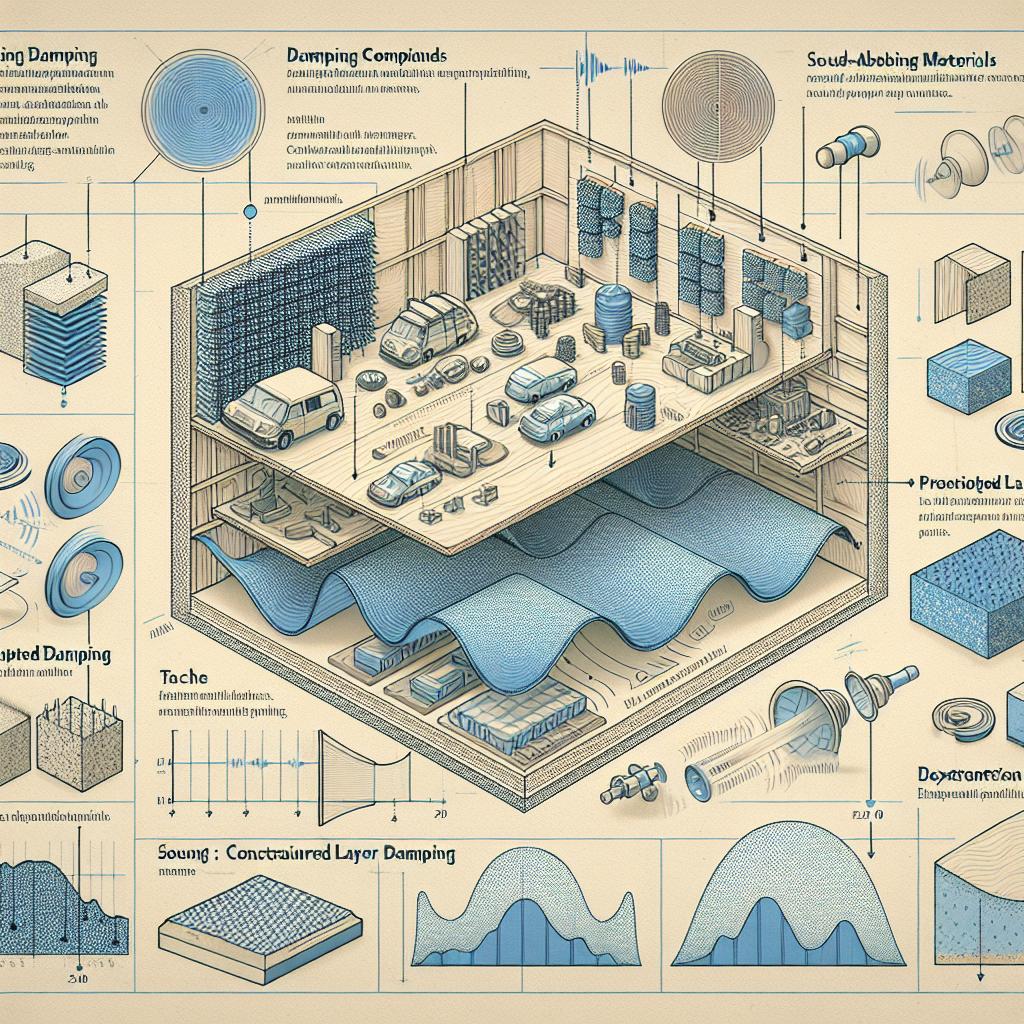Installing a mini split air conditioning system can transform your living space into a cool oasis, especially during the sweltering months of summer. Yet, amidst the excitement of upgrading your comfort, there’s an often-overlooked aspect of installation that can disrupt the tranquility of your home: noise and vibration. These unwelcome byproducts can arise from improper mounting, inadequate insulation, or a lack of planning, potentially hindering the peace you seek. In this article, we’ll explore effective strategies to minimize noise and vibration during the installation process of your mini split AC, ensuring that when the temperatures rise, it’s only the cool air that fills your space—not the clatter and rumble of mechanical disturbances. Let’s dive into practical tips and insights that enable you to create a serene living environment while enjoying the benefits of modern cooling technology.
Choosing the Right Location for Optimal Performance
When selecting a site for your mini split AC installation, it’s crucial to consider both the external and internal environments to ensure optimal performance while minimizing noise and vibration. Avoid areas near bedrooms or study spaces, as the compressor unit can produce sound that may be disruptive. Instead, look for a location that has sufficient clearance from neighboring structures to facilitate proper airflow, which in turn can help in reducing noise transmission. Additionally, ensure the unit is mounted on a solid and level surface; this can greatly diminish vibrations during operation.
To further enhance your installation’s effectiveness, consider the surrounding obstacles and their potential impact on sound and airflow. Implementing the following strategies can contribute significantly to improved comfort:
- Choose a shady spot to prevent the unit from working harder due to heat, minimizing operational noise.
- Install sound-dampening materials around the unit if proximity to living areas is unavoidable.
- Utilize vibration isolation mounts to absorb shocks and reduce noise during cooling cycles.
In addition, preparing an exit plan for condensate drainage will help eliminate any excess water noise. An organized layout can be documented in a simple table:
| Location Choice | Noise Consideration | Cooling Efficiency |
|---|---|---|
| Near the Roof | Less noise interference | Optimal airflow |
| Corner of the Yard | Moderate sound reflection | Good thermal distribution |
| Beside a Wall | Higher noise absorption required | Potential airflow blockage |

Materials and Techniques to Dampen Noise and Vibration
To effectively minimize noise and vibration during the installation of mini split air conditioning systems, the selection of suitable materials is crucial. Using vibration isolation pads made from materials like rubber or neoprene can significantly absorb shocks and vibrations from the compressor unit. Additionally, incorporating acoustic insulation in the surrounding walls can further dampen sound transmission, creating a quieter environment. Consider employing a combination of the following materials for optimal results:
- Mass Loaded Vinyl (MLV): Highly effective for soundproofing in walls that share proximity to the unit.
- Foam Panels: Placed within the ceiling or walls, these absorb sound waves effectively.
- Soft Underlayment: Ideal for supporting the indoor unit to minimize floor vibrations.
In addition to the right materials, specific techniques can enhance the overall noise reduction strategy. Ensure that all mounting brackets and fixtures are tightly secured to eliminate rattling and loose components that can amplify sound. Furthermore, consider the layout of the installation; positioning the compressor away from living spaces can help diminish noise levels. The following table outlines additional techniques to implement:
| Technique | Description |
|---|---|
| Flexible Ducts | Use insulated flexible ducts to minimize airflow noise. |
| Sound Barriers | Install barriers between the outdoor unit and residential areas. |
| Regular Maintenance | Routine checks to ensure system performance and noise levels. |

Expert Installation Tips for Quieter Operation
To achieve a quieter operation during your mini split AC installation, selecting the right location for both the indoor and outdoor units is crucial. Consider placing the outdoor unit on a solid, stable surface, such as a concrete pad, which minimizes vibrations that can travel to the surrounding environment. Additionally, use anti-vibration pads designed for HVAC systems; these are effective in isolating vibrations and reducing noise levels. Ensure that the indoor unit is mounted on an interior wall away from bedrooms and living spaces, which can further mitigate sound transmission.
Another important factor in minimizing noise is the correct installation of the refrigerant lines and electrical wires. Properly securing these lines can minimize rattling sounds, so use brackets or clips at regular intervals along their path. Additionally, apply insulation to the refrigerant lines to reduce noise caused by fluid movement and temperature changes. If you anticipate extreme outdoor conditions, consider encapsulating the outdoor unit with acoustical barriers to absorb excess sound without compromising airflow. Following these tips will enhance the efficiency and comfort of your mini split AC system while keeping noise to a minimum.
Routine Maintenance Practices for Sustained Quietness
To ensure that your mini split AC operates quietly over time, routine maintenance practices are essential. Regular checks on filters, coils, and drain lines can prevent unnecessary noise caused by obstructions or failures. Cleaning or replacing filters every 1-3 months is particularly important, as dirty filters can restrict airflow and lead to increased sounds. Additionally, ensure that the outdoor unit is free from debris and vegetation that could hinder its performance. Keep an eye on the mounting pads and brackets, as any shifts or corrosion can amplify vibrations. Regular inspections and cleanings not only maintain quiet function but also extend the lifespan of your system.
Moreover, periodic professional servicing is invaluable. Scheduling a service every year will help identify potential issues before they escalate. During these check-ups, trained technicians can perform tasks such as tightening loose components and checking refrigerant levels. It’s also a good opportunity to balance the system if any misalignment is detected, reducing unnecessary operational sounds. Keeping a maintenance log can help track dates of services and any noted issues. Here’s a simple table format to guide your routine checks:
| Task | Frequency | Notes |
|---|---|---|
| Replace/clean filters | 1-3 months | Check for dirt accumulation. |
| Inspect outdoor unit | Monthly | Remove debris, check airflow. |
| Professional servicing | Annually | Includes tune-ups & alignment. |
Q&A
Q&A: How to Minimize Noise and Vibration during Mini Split AC Installation
Q1: Why is noise and vibration a concern when installing a mini split AC system?
A1: Noise and vibration can significantly impact the comfort of your living space. While mini split systems are typically quieter than traditional HVAC units, improper installation can lead to increased vibrations and sound disturbances. This can disrupt your daily activities and overall comfort, making it crucial to minimize these factors during the installation process.
Q2: What are the main sources of noise and vibration in a mini split AC system?
A2: The main sources of noise and vibration are the compressor and fan motors. Vibrations can also be transmitted through unbalanced mounting or improper connections. Furthermore, if the indoor and outdoor units are not placed correctly, the resulting sound energy can resonate through walls and floors, amplifying noise levels.
Q3: What steps can I take during installation to reduce noise?
A3: Start by selecting the right mounting location for both the indoor and outdoor units, away from bedrooms or common areas. Insulating materials can be used to wrap the compressor and pipes, helping to absorb sound. Additionally, utilizing vibration-dampening mounts or pads will diminish the transmission of vibrations to the building structure.
Q4: Should I prioritize the installation process by hiring professionals?
A4: Yes, hiring experienced professionals can make a significant difference in minimizing noise and vibration. They have the expertise to ensure that all components are properly installed, calibrated, and adjusted, leading to reduced operational noise. Professionals can also recommend the best practices for your specific installation and help you choose high-quality equipment that operates more quietly.
Q5: Are there specific tools or materials that can help mitigate noise and vibration?
A5: Absolutely! Acoustic insulation material, rubber mounting pads, and anti-vibration mats are excellent for soundproofing. Tools such as a vibration analyzer can also help ensure that all parts are balanced and functioning correctly. Ensuring proper alignment during installation is vital in decreasing the potential for noise.
Q6: Is it possible to further reduce noise during the operation of the mini split AC?
A6: Yes! Routine maintenance, such as cleaning filters and ensuring that outdoor units are free from debris, can maintain efficiency and reduce noise. Additionally, consider scheduling cooling during off-peak hours or using a variable-speed compressor model, which operates more quietly than traditional systems.
Q7: What’s the long-term benefit of minimizing noise and vibration during installation?
A7: Minimizing noise and vibration during installation not only leads to immediate comfort but also enhances the longevity and efficiency of your mini split AC system. A well-installed system uses less energy, which can save on utility bills, and operates more consistently, improving your indoor air quality for years to come. Plus, you’ll enjoy a more peaceful living space!
Q8: Can I perform any follow-up adjustments after the installation to further reduce noise?
A8: Definitely! Post-installation adjustments, such as tightening loose bolts or recalibrating the system, can help reduce noise. If you find that noise levels are still higher than desired after installation, consulting with a professional can help identify additional adjustments or enhancements.
By addressing noise and vibration thoughtfully during installation, you can create a more enjoyable environment in your home while optimizing the performance of your mini split AC system.
To Wrap It Up
the installation of a mini split air conditioning system can significantly enhance your home’s comfort, but it’s essential to ensure that this process is as peaceful as it is efficient. By following the strategies outlined in this article—such as selecting the right location, using vibration isolation techniques, and opting for quality materials—you can effectively minimize noise and vibration during installation. Not only will this protect your living environment from unnecessary disturbances, but it will also contribute to the longevity and performance of your cooling system. Remember, a little planning goes a long way in creating a serene atmosphere where you can fully enjoy the benefits of your new mini split AC. Celebrate your new oasis of comfort, knowing you’ve taken the steps to keep it tranquil and enjoyable for years to come.

